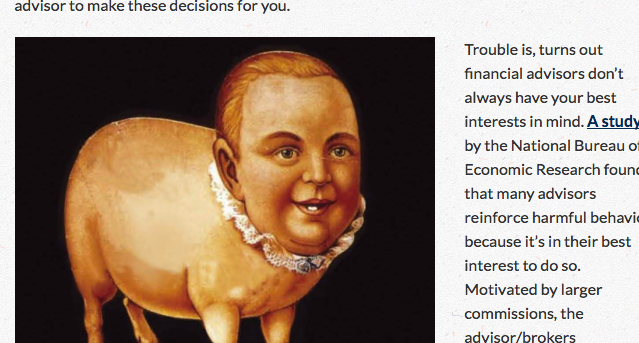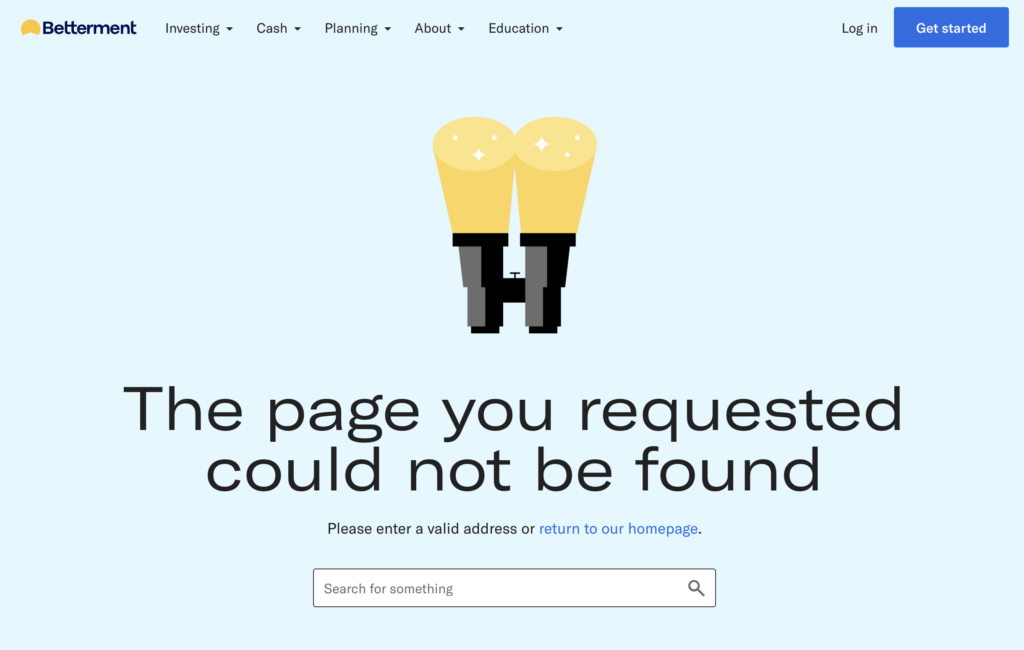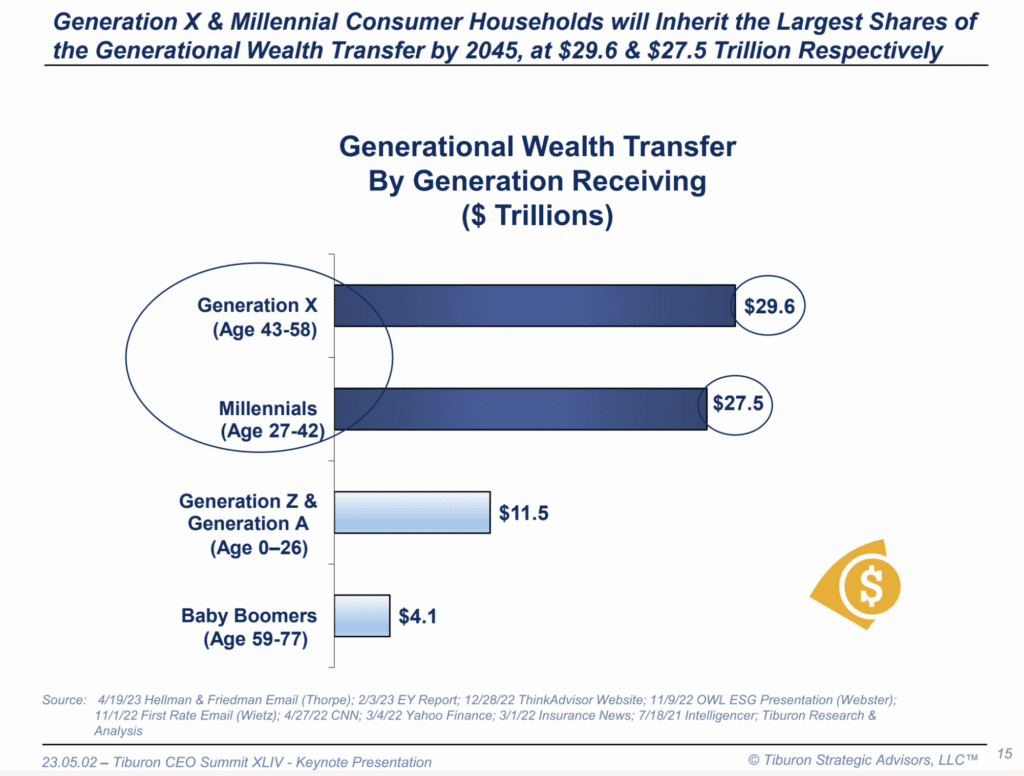Eleven years ago this spring, a startup called Betterment published a blog post stating that human financial advisors were obsolete and that the people who work in the advice industry are pigs. The basis of their post was an NBER study that sent secret shoppers out to meet with “financial advisors” who then received high-cost, unsatisfactory advice. Unfortunately, the advisors in the study turned out to have been commission-based brokers, hopelessly conflicted and highly incentivized to sell expensive products based on their compensation structure. These were not fiduciary investment advisor representatives. They were mostly Series 7-licensed retail stockbrokers. And I should know – I’ve been both during the course of my career.
When Betterment’s post began to spread, it provoked a huge reaction among the advisor community. Mike Alfred, who was running Brightscope at the time, did an article refuting it at Forbes. Brooke Southall picked up the controversy at RIABiz (I wish I loved anything as much as Brooke loves controversy!), Michael Kitces took to Twitter to dismantle the premise and filet the details. As for me, I did what bloggers normally do in the presence of rank disinformation being disseminated among the general public – I destroyed it.
Betterment uses the terms “broker” and “financial advisor” interchangeably in their post, either because they don’t understand the difference or because their weak point benefits from the intentional obfuscation.
The bottom line: If they knew better, they are disingenuous and nasty. If they didn’t know better, then they are stupid.
And lest you think this was all an overreaction, here is the image Betterment used to illustrate their original post:

But that was then. Let me bring you up to speed on what’s happened since.
First, Betterment deleted the post. Don’t bother looking for it, it’s gone.

I think they did the right thing in taking it down. And I understand the motivation behind putting it up in the first place.
Jon Stein, Betterment’s founder and then CEO, along with his original staff, saw themselves as the insurgents and this was them waving the Jolly Roger to put the industry on notice. I was a little bit of an asshole myself when I started blogging. I wrote all sorts of stuff I wish I hadn’t during the early, rebellious phase of this site. Besides, Betterment did have a point about the industry and its motivations, despite their inarticulate effort at exposition.
Advisors vs Brokers
You see, in the early 2010’s there was a fight over whether or not the brokerage firms who were holding themselves out the public as “advisors” ought to be held to a fiduciary standard of care as opposed to the less stringent “suitability” standard. But they wanted to have their cake and eat it too – advertise as advisors but sell like transactional brokers. The public did not understand the difference between brokerage services and fiduciary advisors. I wrote a whole book about it, but the gist was that most civilians had “my financial guy” and they didn’t know that someone doing fee-based business beholden only to clients was giving advice while someone selling them products, paid a commission by the issuer of the security, was, therefore, not a fiduciary or giving them advice under the legal definition.
This has largely resolved itself over the last decade as Regulation Best Interest (BI) has raised the standard of care for brokers. Many brokerages have gone extinct while the practitioners have transformed themselves into fee-only advisors. The advice side won, the product sales side is slowly fading away with every passing year. The rise of commission-free trading in the late 2010’s was the final nail in its coffin. You’d be hard-pressed to find a reputable firm that focuses on product sales these days (outside of insurance). It’s pretty much over.
And to Betterment’s credit, while they didn’t seem to understand the difference between fiduciary advice and the conflicted brokerages, a lot of smaller investors were, in fact, left with a lack of good solutions. Broker-dealers lobbied to retain the ability to sell high-cost products to the public using the argument that accounts of a certain size were not worth servicing if they couldn’t be f***ed over. They didn’t put it that way, of course, but that was the argument (see: The Most Horrendous Lie on Wall Street, my piece at Fortune Magazine from 2016). They laundered this perspective under the guise of “we’re providing more choice” to the public and letting people decide for themselves what’s in their best interest. But of course, unsophisticated investors had absolutely no idea what was in their best interest. Just look at how they vote. Information asymmetry was how brokers made most of their money. And then they sold these smaller clients whole life policies in place of index funds, private REITs in place of bonds, closed-end funds in place of ETFs, unit investment trusts in place of mutual funds, etc.
So if you were an investor whose portfolio did not meet the traditional wealth management minimum of $1 million, there was a good chance the only firms eager to speak with you were those who could sell you products for embedded concessions and trade securities for you on a commission basis. People with over a million dollars, on the other hand, had fee-only fiduciaries tripping over themselves to build them financial plans and managed accounts with reasonable costs.
The Revolution
This was before the advent of a lot of the technologies we have now. Betterment was responsible for ushering in a world with great alternatives for the mass affluent, sub-$1 million retail investor. They had a great idea even if I disliked the disingenuous way they were promoting it. And it worked. At the time of their post, Betterment had about $50 million in assets under management, with average account sizes of $2500. Today, just over a decade later, they manage over $32 billion. More importantly, the revolution they helped spark has put a lot of the bad alternatives out of commission (pun intended) and has inspired a generation of like-minded startups to build something better than what used to exist.
Some of the largest brokerages in the industry used the idea to build robo-advisory platforms of their own, most notably Schwab’s Intelligent Portfolios and Vanguard’s Digital Advisor. Merrill Lynch remade their call center into Merrill Edge, cutting the cost of cold-callers, reams of paperwork and 1-800 numbers with a more modern email + digital user interface. Merrill Edge does not bill itself as “robo-advice” per se and does staff itself with human advisors, but in reality it is probably the largest robo-advisor in the world with over $320 billion in assets under management. Vanguard’s service oversees $130 billion and Schwab’s product is said to manage approximately $70 billion (I google-searched these figures, they might not be perfectly up to date). It’s important to point out that this is money these firms would probably be managing anyway. Turning call center operations into digital advice platforms was more an evolution than a revolution, but either way the clients are getting something better than just having a brokerage account with all sorts of random products thrown into it, which is what the industry used to look like. Now there is cohesion. Portfolios being driven by investor goals. It’s not sexy or technologically advanced – these accounts mostly resemble an unbundled lifecycle mutual fund with some tax loss harvesting benefits – but it works. Reasonable asset allocation delivered – at scale – to millions of unsophisticated people who, a generation prior, would have been either completely ignored or ravaged by unscrupulous salesmonsters.
The Creation of Liftoff
A funny thing happened since that pig post. We made friends with the Betterment guys and started doing business with them.
About ten years ago, my firm decided to launch a robo-advisor of our own just to see if we could offer a better alternative to our fans who had less than a million bucks. Prior to launching, we were turning down hundreds of people who had emailed us for help, sending them out into the wild to be mauled by wolves. “Sorry, you don’t meet our minimum” was a terrible answer, especially considering that these were not just random people reaching out, these were our readers. Our fans. It felt awful, but we simply did not have the resources or staff to take these investors on. We launched a platform called Liftoff to service these clients and had been bouncing back and forth between technology providers for a few years before we finally got it right. In 2019 we moved the platform over to Betterment’s Betterment for Advisors, working with Jon Stein and our friend Dan Egan to finally realize the full potential of our offering.
You can watch the video of our launch, live from Betterment headquarters below:
Today, we service about 500 clients at Liftoff with an aggregate account value of approximately $44 million. The average account size is $93,000 versus an average of $77,000 as of the end of 2022. These 500 clients would not have qualified under the industry-standard million dollar minimum. Without Liftoff, we would never have gotten to know these people or have been able to help them. Now, thanks to Betterment’s underlying technology, we have a solution that can help. These households represent the future of our practice. We have multiple certified financial planners working with them on everything from inheritances to annual retirement contributions to goal-setting to tax issues. Liftoff clients get regular updates on the status of their portfolios, including regular email alerts detailing tax loss harvesting activity and dividend payments. Now, $44 million might not sound like a lot of money to you, but for the thirty-something year old dad on our platform who’s managed to put away $50,000 despite all of the cost-of-living challenges in today’s economy, that’s all the money in the world to him. And we treat it as such.
Who knows where these clients would be invested today if not for Liftoff? Now I know that our fans who are not yet liquid millionaires are being looked after and taken care of. It feels great to be able to type these words and I will be forever grateful to Jon, Dan and the rest of the team there, including Betterment’s current CEO, Sarah Levy. Sarah will be speaking live at this September’s Future Proof Festival and they have been wonderful partners to us since day one. I wanted to spend a few lines clarifying this because there have been a few articles in the press speculating on our partnership. I don’t fault the reporters for asking these questions. We just weren’t at liberty to discuss this stuff as we completed our recent transaction – more on that in a second.
Robo Today
Let’s spend a moment discussing where robo-advice is now to bring this history full circle. To a large extent, robos have become commoditized and the customer acquisition costs have been the pain point for these companies’ ability to scale. I think everyone would acknowledge Betterment as being the industry’s leader and the company has had a lot of success in areas like building tools for human financial advisory firms as well as Betterment for Business, their much lauded 401(k) platform. Wealthfront, another early entrant, has also accumulated roughly $30 billion in assets, but the founder’s vision of a world without human advisors has not exactly played out. In fact, human financial advisors are managing more money than ever before and represent one of the fastest growing segments within the entire financial services industry. Every major bank, brokerage and investment firm has told its investors that it sees wealth management as being key to their future growth, from JPMorgan to Goldman Sachs. Private equity has been pouring into our space over the last ten years in a tidal flood of capital. RIAs across America have built billions and billions of dollars worth of equity value by offering human-driven and administered advice. This boom shows no signs of letting up any time soon as 69 million boomers and 75 million millennials increasingly choose a person or people to help them with some of the toughest, most consequential decisions they will ever have to make in their lifetime.
Robo-advice as a category has found itself in competition with existing do-it-yourself solutions like online brokerage accounts. There is no RIA founder in America today who sees robo-advice as a primary or even secondary competitor. It’s a different customer and, most likely, it’s a future customer. In the accumulation phase, a younger person adding to their accounts while focusing on starting a family and a career is very well served by robo- or automated advisory services. And then, when a life event happens or the complexity of their situation increases, they go out and look for a professional to help out or take over.
The State of Advice
TurboTax didn’t eliminate the human accountant. In fact, there are probably more CPAs and enrolled agents than ever before. Financial advice is no different. Our business is teeming with new entrants and, if anything, there aren’t enough people giving financial advice to service all the demand. Don’t take my word for it. Look at the statistics. The below data comes from Chip Roame’s keynote presentation at last month’s Tiburon CEO Summit in Boston, which I attended.
In 2015, wealth management firms had $17.5 trillion under management and as of the end of 2022 it’s $35.3 trillion. In seven years our industry’s assets have doubled. Whatever word is the opposite of “disruption” would surely be applicable here. Between 2012 and 2022, Tiburon finds, the growth in industry assets has been 30% attributable to organic growth (meaning not from market effects).
Registered Investment Advisor firms had net inflows of $342 billion in 2022. In 2021 it reached an all-time high of $411 billion. Compare that to 2012, the year the robo-advisors came on the scene. Ten years ago RIAs had only taken in $43 billion. To be 10xing the annual inflow number a decade after the advent of robo-advice makes it clear that the industry hasn’t been phased in the least. You can launch another Sofi or another Personal Capital every year, buy up all the naming rights to all the football stadiums in the NFL and none of that will change the fact that rich people want to be advised, not emailed. Asset allocation isn’t advice. Advice is advice.
A thousand would-be disruptors have come and gone, their venture backers too, and the status quo has only gotten status quo-ier. The first recorded story of a financial advisor in human history was Joseph, advising Egypt’s Pharaoh through a fourteen year stretch of feast and famine. Joseph was paid an AUM-based fee in the form of a percentage of the farmland. Look it up.
Whither Wealthfront?
In a twist of irony more delicious than a thousand Cinnabons, the aforementioned Wealthfront actually tried to sell itself to none other than the aggressively human advisor-driven UBS Wealth Management last year. No company on earth better encapsulates the antithesis of Wealthfront’s vision for the future than UBS. It would be like if a chain of yoga studios tried to sell itself to Arby’s. And, irony on top of irony, the deal actually fell apart, with UBS maintaining a small equity stake while walking away from the purchase. No one knows why. It’s been speculated that shareholders were unhappy with the purchase price ($1.4 billion) as tech valuations broadly collapsed. There were rumors of banking regulators taking issue with the transaction – probably nonsense, look at how relieved everyone was when UBS was willing to absorb its largest competitor, Credit Suisse, six months later. Whatever the reason, it did not appear that UBS was particularly dedicated to making it work. Cold feet is as good an explanation as any. Wealthfront is now the robo-advisor determined to dislodge human advisors, having tried and failed to sell itself to perhaps the world’s largest human advisory firm. “Your revolution is over, Mr. Lebowski. Condolences.”
The thing many of the first-generation robo-advisor firms got backwards was the value proposition. This was because none of the first-gen founders were financial advisors. They were technologists and consultants. They thought the value was in the portfolio management, fund selection and the user interface. That stuff is important – can’t have horrible performance and clunky websites – but it’s not the big thing.
The big thing was always and will always be the relationship. Anyone who’s spent any time in our business could have told them that. Ric Edelman tried, in an on-stage debate with Adam Nash, Wealthfront’s former CEO. Ric said that a lot of financial advisors wouldn’t be here in a few years. Then he turned to Adam and said “I’m not so sure you’ll be here either.” Edelman Financial Engines is both the largest RIA in America as well as one of the largest automated advice platforms. He made the bet that the future would be a combination of people and tech. He won his bet, to the tune of $291 billion in assets under management.
How do we know that relationships are the big thing? Well, why do you think thousands of advisors are able to move firms every year and bring their clients with them? Better tech? LOL. Nobody chooses an advisor or a firm on that basis. Technology gets commoditized. If a tool is useful, eventually everyone else will have access to it or some approximation. Technology flattens the playing field as it proliferates. However, close relationships with people we like or trust by definition cannot be commoditized. How many people in your life do you actually like? How many do you truly believe in? How many can you trust to be there when it matters? Not hundreds. Probably not even dozens. Like, five? Six? Now imagine the trust built between an investor and her financial advisor having been through the shared experience of a massive bear market together. Tough times build bonds between people. Now imagine trying to pry that relationship apart with a TV commercial or a banner ad.
A Comedic Interlude
Something else worth mentioning: The failure of the marketing. In the early going, there was this instinct on the part of the robo-advisors to play up the robo aspect of what they were doing. The ads and imagery had all sorts of cybernetic connotations and goofy-looking humanoid automatons running their lacquered white fingers across keyboards. It was never cool. And even if it was, nobody wants anything to do with that. The average investor couldn’t think of anything less appealing than entrusting their savings to an Isaac Asimov novel.
Some selected samples of this era’s iconongraphy below (captions are mine):

Look, it’s the Wolf of Wall Server!

Money popping out of a laptop? Is this crypto?

Great meeting, guys. Want us to plug you back into your charger now?

I think it’s buying NVDA

Okay, this one’s awfully…anatomical
Honestly what the hell were these people thinking?
No Contest
Betterment wisely steered away from this sort of aesthetic and played up the humanity of its clients instead. Personal Capital, since acquired, was the first of the robo-advisors to feature its human financial planning element as part of the package. This was the right angle. The ones that went full Wall-E World didn’t fare as well. Regardless, life went on for the rest of the business, as the robo tide ebbed from the front page and washed out to the margins. I probably spoke on fifteen or twenty panels about robo advice between 2013 and 2018 at various financial advisor conferences. Then they just sort of stopped having them. The industry trades stopped writing about them. Why was robo suddenly old news? Because the concept got commoditized, the threat was neutralized and readers lost interest. News is a business. When people stop clicking on a topic, editors stop assigning stories on that topic. Reporters focus elsewhere.
The RIA space has been so successful, despite this imagined challenge from robo-advice, that we now have over 258 firms in our industry that manage over $10 billion in assets. In 2011, there were just ten. The 6% of RIAs that have grown larger than $1 billion captured 76% of all net flows last year. The other 94% of RIAs, who are managing less than $1 billion pulled in the other 24% of net flows. Power laws still apply, but there is no question that RIAs have risen to the challenge and not only survived, but thrived.
The Future
So what comes next? Probably increasing human advisor usage of robo-advice tools and tactics. Again, picture accountants using TurboTax inside their own practices to serve more clients more efficiently. They are augmented, not disintermediated.
One other thing that’s going to be funny – they’re going to take all the old articles from ten years ago and re-publish them but swap out the term Robo-advisor and replace it with AI. I could write one of these articles with my eyes closed – a headline teasing what percentage of financial advisors may lose their jobs by 2030, a Gartner study, a quote from Kitces, a vignette about such-and-such startup raising money from Point72 Capital, a mention of whatever Envestnet is building, a cautionary concluding paragraph about how it’s too soon to tell. The usual. I’ll have a more extensive take of my own about how AI will affect the industry but it’s too early for me to write anything of value. We are playing with some of the cutting edge stuff that people invite us to try but it’s not even the first inning.
Moving on…
The Boomer generation has approximately $61.4 trillion in investable assets plus another $29.4 trillion in retirement plan assets, which adds up to a total of $90.8 trillion. Some of that will be liquidated to live on, most will be transferred. Keep in mind the Boomers still have another $50.3 trillion in personal assets like houses and property, not to mention an additional $16.9 trillion in small business ownership valuation. They couldn’t spend this down in the time they have left if they tried. And if you know anything about advising Boomer clients, you know they can’t bear to spend their own money on themselves. It’s actually one of the biggest challenges advisors face today.

(courtesy of Tiburon Research, used without permission but they’ll forgive me)
While Boomers have the lion’s share of the assets our industry manages, things are changing. The industry is changing to adapt. The money is moving and RIAs are moving to better serve the new clientele.
Most of this money will will continue to be managed as it passes down to the next generations – people aged 27 to 58 who are inheriting from their parents and coming into their own peak earning and investing years simultaneously. Tiburon pegs this inheritance as being on the order of $29.6 trillion and $27.5 trillion for the Gen Xers and Millennials, respectively, by 2045. It’s not going to happen, it already is.
We have been building our firm to prepare for this for the last ten years. A million hours spent creating useful, helpful content and building an army of fans who are now on the receiving end of this ocean of money. The bet we’ve made is that they are going to turn to people they know and trust when the time comes. That bet pays each time we get an email to the effect of “My dad doesn’t know what to do with his money so I’d like to set up a meeting with you guys to talk to him about it.” Or “My mom needs your help, she doesn’t have anyone she can trust to talk to.” In more recent years, those emails have sounded more along the lines of “I am making a lot of money but my hours at the law firm are crazy and I have no time to get organized and no one to ask questions.” We have been paddling in front of this wave for a decade and now we’re starting to stand up on the board.
There might be another RIA firm in America better positioned for this, but I couldn’t guess who that might be. I think it’s us. Building that trust with the audience is my life’s work. Every day someone in our orbit is experiencing the death of a loved one, a promotion at work, a business sale, a marriage, a divorce, a child born or some other major life event. We are standing by ready to help and they know it. We will not send them away. We will not let them down. There is no question or situation too hard for us to take on. And now there is no capacity restraint either.
Thanks to technology, our readers, listeners, viewers, followers and friends don’t have to wait until they have a million dollars. We are ready to meet people where they are, right now, in their moment of need.
Which brings me to my final point (thanks for sticking with me this long). This week, right here at The Reformed Broker, I will be unveiling what I consider to be the culmination of everything I’ve learned about the intersection of technology, financial planning and asset management. There have been a lot of questions about our acquisition of Future Advisor from BlackRock, what our intentions are, whom we will be serving and how. I will answer them all now that the transaction has closed and our new service is ready for the public. I really hope you like what we’ve been working on.
See you then.



